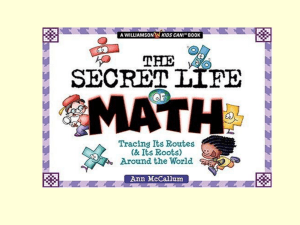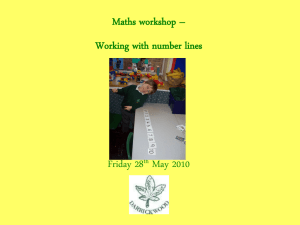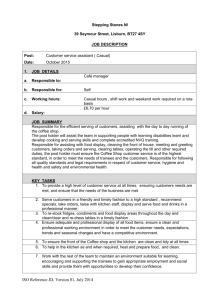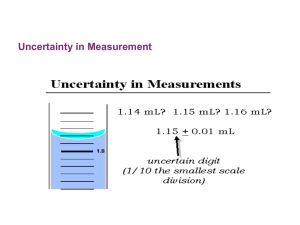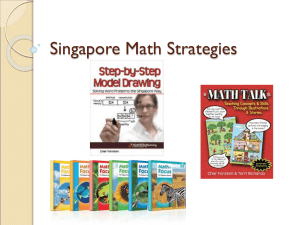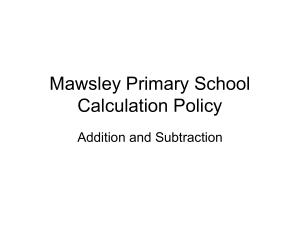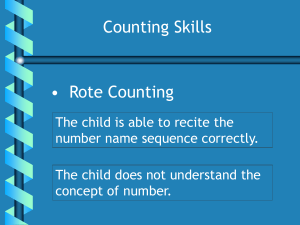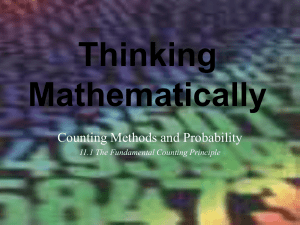Foundation Unit — AusVELS Curriculum: Mathematics
advertisement
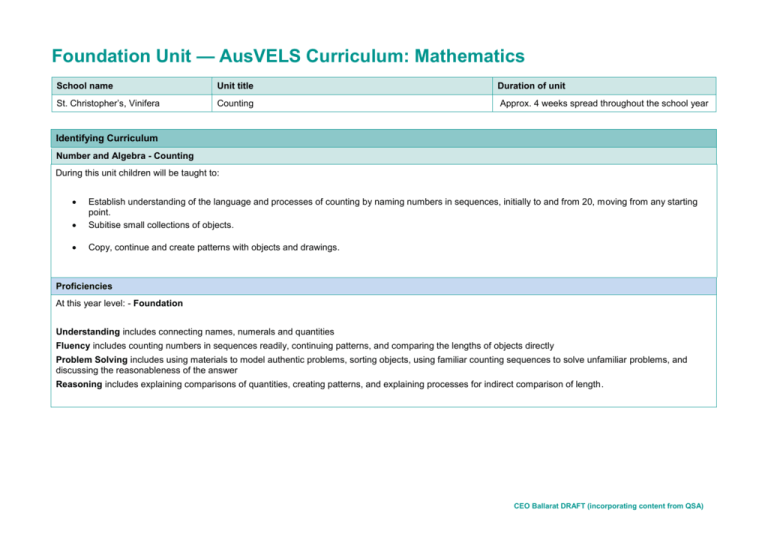
Foundation Unit — AusVELS Curriculum: Mathematics School name Unit title Duration of unit St. Christopher’s, Vinifera Counting Approx. 4 weeks spread throughout the school year Identifying Curriculum Number and Algebra - Counting During this unit children will be taught to: Establish understanding of the language and processes of counting by naming numbers in sequences, initially to and from 20, moving from any starting point. Subitise small collections of objects. Copy, continue and create patterns with objects and drawings. Proficiencies At this year level: - Foundation Understanding includes connecting names, numerals and quantities Fluency includes counting numbers in sequences readily, continuing patterns, and comparing the lengths of objects directly Problem Solving includes using materials to model authentic problems, sorting objects, using familiar counting sequences to solve unfamiliar problems, and discussing the reasonableness of the answer Reasoning includes explaining comparisons of quantities, creating patterns, and explaining processes for indirect comparison of length. CEO Ballarat DRAFT (incorporating content from QSA) Relevant prior curriculum Curriculum working towards Active investigation of mathematical ideas in everyday life. In the AusVELS Curriculum: Mathematics at Year 1 Number and Algebra Develop confidence with number sequences to and from 100 by ones from any starting point. Skip count by twos, fives and tens starting from zero Count collections to 100 by partitioning numbers using place value. Bridging content Throughout Foundation children build early mathematical understandings about number by: investigating and communicating about quantities and their representations, and attributes of objects and collections. Achievement standard Foundation: students make the connections between number names, numerals and quantities up to 10 Links to other learning areas Assessment Describe the assessment Relevant components of Stepping Stones Quarterly Tests In-class observations Portfolio Samples MAI – Section A: Counting 2 Assessment date Teaching and learning Teaching strategies and learning experiences AusVELS Content Descriptions Stepping Stones Modules Connection to MAI Growth Points Stepping Stones Support Resources Establish Understanding of the language and processes of counting by naming numbers in sequence initially to and from 20, moving from any starting point Learning Experiences Mathedology: Whole class Counting: Growth Point 1 1.3, 1.4, 2.1, 2.2, 3.3, 3.4,4.1, 4.2, 4.4 Growth Point 2 (Stepping Stones goes beyond and includes work with $1 coins) Small group 3.4.1, 4.1.1, 4.1.2, 4.4.1, 4.4.2 Whole class 5.1, 5.2, 6.1, 6.2, 5.4, 8.3, 8.4 RTN1 Teaching Number: Counting RSRQ Developing Sight Recognition of Quantity (Subitising) Big Books: The Bug Day Out I See, You See Shoes In Twos Paint a Rainbow Fundamentals: Small group Move On Up (couniting one, two or three) 5.4.1, 5.4.2, 6.1.2, 6.2.1, 6.2.2, 8.3.2, 8.4.1, 8.4.2. Toss and Move (directions forward and back) 12.2.1 More or Less (comparing quantities to 10) Whole class Before and After (relative position to 10) Along the Track (relative position to 10) 13.1, 13.2, 13.3, 13.4, 14.1, 14.2, 15.1, 15.2, 16.1 Along The Track Again (relative position of 1 to 15) Small group Moving On (counting 11 to 16) 13.3.1, 13.3.2, 13.4.1, 13.4.2, 14.1.1, 14.1.2, 14.2.1, 14.2.2, 15.1.1, 15.1.2 Flare: Number Board Number Track Number Line CEO Ballarat DRAFT (incorporating content from QSA) Teaching and learning Teaching strategies and learning experiences AusVELS Content Descriptions Stepping Stones Modules Connection to MAI Growth Points Subitise small collections of objects Learning Experiences Whole class Counting: Growth Point 1 3.4 Growth Point 2 Small group 1.3.2, 2.2.2, 3.2.1, 3.3.1, 3.4.2, 4.2.1, 4.2.2 Whole class 6.3, 8.2 Small group 6.3.1 Whole class 9.1 Small group 9.1.1, 9.1.2, 10.4.1 Whole class 16.2, 16.3, 16.4 Small group 13.3.2, 16.3.1, 16.3.2, 16.4.2 4 Stepping Stones Support Resources Teaching and learning Teaching strategies and learning experiences AusVELS Content Descriptions Stepping Stones Modules Connection to MAI Growth Points Copy, continue and create patterns with objects and drawings Learning Experience Whole class Counting: Growth Point 1 1.1, 1.2, 2.4 Growth Point 2 Stepping Stones Support Resources 7.3, 7.4 Small group 7.3.1, 7.3.2, 7.4.1, 7.4.2 Whole class 12.3, 12.4 Small group 12.3.1, 12.3,2, 12.4.1, 12.4.2 Whole class 13.1, 13.2 Small group 13.1.1, 13.1.2, 13.2.1, 13.2.2 CEO Ballarat DRAFT (incorporating content from QSA) Use feedback Ways to monitor learning and assessment Teachers meet to collaboratively plan the teaching, learning and assessment to meet the needs of all learners in each unit. Feedback to students Teachers strategically plan opportunities and ways to provide ongoing feedback (both written and informal) and encouragement to children/students on their strengths and areas for improvement. Teachers create opportunities for discussion about levels of achievement to develop shared understandings; co-mark or cross mark at key points to ensure consistency of judgments; and participate in moderating samples of student work at school or cluster level to reach consensus and consistency. Children/Students reflect on and discuss with their teachers or peers what they can do well and what they need to improve. Teachers reflect on and review learning opportunities to incorporate specific learning experiences and provide multiple opportunities for children to experience, practise and improve. Reflection on the unit plan Identify what worked well during and at the end of the unit, including: activities that worked well and why activities that could be improved and how assessment that worked well and why assessment that could be improved and how common student misconceptions that need, or needed, to be clarified. 6

